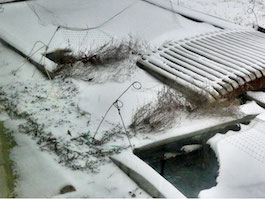by Frank Cowherd
So it is never too late to put a hole in the ice on your pond. We came back from vacation, Christmas in California, about January 4th to find the ponds at home in Maryland had 4, maybe 6, inches of ice on them. I have put holes in thick ice many times over the last ten years, so it was fairly easy to repeat.
I set up the air system using a small vibrator air pump for each pond. I wound their cords around the pumps to leave about 6 inches to the plug and plugged them into a heavy-duty extension cord. Heavy-duty extension cord is needed to handle the weather not the amount of electricity used. To protect the pumps from the weather, get two plastic fish bags, one inside the other, and put a hole in the bottoms big enough to put the extension cord through. See Figure 1 below. Thread the extension cord through the hold and plug it into an outdoor outlet. Seal the extension cord in place with a zip-tie to prevent water or snow getting in from that end. Get the pump or pumps into the bag with enough airline tubing sticking out to reach the pond or ponds. Seal the open end of the bag with a couple more zip-ties but do it loosely so air can get into the bag and to the pumps. You can hang the bag and pumps up or just lay it on the ground, maybe on something like a board. The airline sticking out of the bag should be long enough to reach about 6 to 10 inches down into the pond. Get a piece of 1-inch PVC that is about 9 to 12 inches long and put two holes in it at one end. One hole should be about half an inch from the end and the other about and inch below. Thread the airline tubing from the inside of the tube through the first hole and then back into the tube through the second hole. See Figure 2 below. This threading is to prevent the tubing from slipping out which does happen if you use only one hole in the PVC, particularly if that hole is even a smidgen larger than the airline tubing. The PVC is really the weight that holds the airline tube underwater. I have not tried using an air stone, but an air stone should work as well.

It is easiest to place the PVC tube in the pond before the water freezes. But if you are like me and think the water will not freeze this year, you will have to put a hole through the ice. Like I said, the ice was over four inches thick when we got back from vacation. Putting a hole through the ice is not hard if you use a large pot of hot water and the PVC tube you prepared above. Do not get lax and pour hot water on your fingers. Stand the PVC upright on the ice. Maneuver the lip of the pot into the top of the PVC tube to hold the PVC in place vertically. Then slowly pour the hot water into the top of the PVC tube. This procedure keeps the hottest water in contact with the ice. It just took me two pots of hot water and about 5 minutes per hole to get the PVC tubes into the ponds. The initial hole formed was maybe 3 or 4 inches wide. As you can see in one of the pictures below that the holes in the ice are a lot bigger caused by the moving water.
By the next morning the holes were as seen in Figure 3. Moving water does not easily freeze. The heat for keeping the hole in the ice comes from the ground in which the pond is. Therefore this method of keeping a hole in the ice is not likely to work well with an above ground pond or a small pond.
I have tried the heaters for animal watering troughs and found them expensive to run. The small vibrator pumps cost less than a couple bucks a month to run.
One tip: assemble the bag with the pump and airline tubing and extension cord inside the house. Plug it in as soon as you can outside since any water or condensate in the lines will freeze quickly and prevent air from being pumped into the pond.

January 5, 2018

